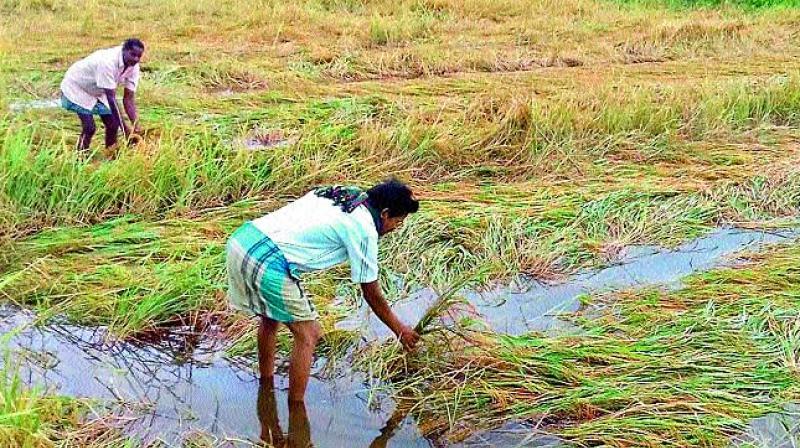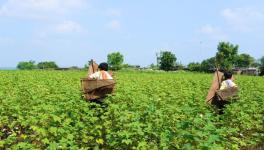Bihar: Rainfall Deficit Adversely Affecting Paddy Transplantation

Representational Image. Image Courtesy: Deccan Chronicle
Patna: In rural Bihar, all eyes are fixed on the sky as millions of farmers as well as landless farm labourers are expecting rains for paddy seedlings transplantation these days. It is an unusual sight for the ongoing monsoon season. Faced with a long dry spell, farmers are now struggling to save their paddy seedlings for transplantation which has already been delayed due to a rainfall deficit.
Sanjay Kumar, an official at Indian Meteorological Department Centre, Patna, told NewsClick that as per the official data, the state recorded 278.4 mm of rainfall from June 1 to July 15, which was 41 % less than the normal 474.2 mm of rainfall. But the state received only 106.3 mm of rainfall from July 1 to July 28, which was 66 % less than the normal 310.9 mm.
As per the rainfall data so far, it is clear that the state recorded a large deficit in rainfall. This badly hit the transplantation of paddy seedlings. An official of the state agriculture department said that till July 27, only 38 % of the transplantation of paddy seedlings has been completed. The department has targeted 35.12 lakh hectares for paddy cultivation this year.
Farmers are hapless as they depend on monsoon rain for paddy cultivation.”Hum logo ka khet aur dhan ka bichra taiyar hai ropni ke liye, magar paani aur varsha ke Kami ke karan ropni shuru nahi hua hai! (Our farmland has developed cracks and paddy seedlings are ready in the nursery for transplantation, but we are yet to start transplantation due to lack of water and rainfall deficit),” Dhananjay Yadav, a marginal farmer and resident of a village in Paliganj block in Patna district, told NewsClick.
Fear of drought-like situations is haunting Yadav due to the poor monsoon to date. He is one of the thousands of farmers facing the brunt of extreme weather due to climate change. Ever since last month, lakhs of farmers across Bihar, mostly small and marginal, have been upset as clouds come and go without drops of rain. It is contrary to their expectation.
Dr Abdus Sattar, a climate change expert at Rajendra Prasad Central Agricultural University at Pusa in Samastipur district, told NewsClick that a long dry spell during monsoon is bad for the paddy crop. “This year although the monsoon onset took place on time (on 13 June) in Bihar, it remained in a weak phase throughout June barring 28-29 June, when good rainfall in the state happened. After that, a long and extended dry spell continued till 19 July. From 20 July till date, rainfall was light to moderate.
Erratic and scanty rainfall during June and July affected the transplanting of rice. As the optimum transplanting window of rice is between 20 June to 15 July, most of the farmers could not transplant during this optimum window due to very poor monsoon and deficit rainfall,” he said.
However, in view of IMD’s forecast of heavy rainfall on July 29 and 30, a senior official of the agriculture department- Aditya Prakash told NewsClcik that the situation will change next week. Farmers will get more rain due to which the transplantation of paddy seedlings will go up. He said that 97% of paddy seedlings prepared by the farmers were ready for transplantation, and if there is sufficient rainfall in the coming days, it will help them.
Taking serious note of deficit rainfall, Bihar Agriculture Minister Amrendra Pratap Singh said that the government was aware of the situation and has asked district officers to provide help to farmers by ensuring the supply of power for hours among other things.
Farmers were hopeful of a normal monsoon, like in 2021 and 2020 when Bihar received surplus rainfall in June-July and paddy output increased. Monsoon normally hits the state between June 12-14.
Bihar’s farmers are heavily dependent on monsoon rain for Kharif crops, mainly paddy, a water-intensive crop.
In Bihar farmers usually go for paddy sowing during Adra Nakshatra after Rohini Nakshatra which starts after June 20. “Farmers have not waited for Adra Nakshatra because of moist fields due to pre-monsoon rains after a long time and timely monsoon rains and sowing paddy”.
Agriculture scientists here said that June-end to July 10 -15 is the best time for paddy transplantation, but farmers are facing a big problem due to the poor monsoon.
In the last 13 years, monsoon rainfall has been above normal five times in June. In 2021, Bihar received 111% surplus rainfall, 82% in 2020, 37% in 2011, 5% in 2013 and 6% in 2022.
An estimated two-thirds of Bihar’s 12 crore population and nearly two-thirds of all agricultural activities are dependent on the monsoon.
Get the latest reports & analysis with people's perspective on Protests, movements & deep analytical videos, discussions of the current affairs in your Telegram app. Subscribe to NewsClick's Telegram channel & get Real-Time updates on stories, as they get published on our website.
























